Cricket in crisis
After a week where cricket made the headlines for all the wrong reasons, we look back on XI other times when the game has taken centre stage for events off the field
|
|
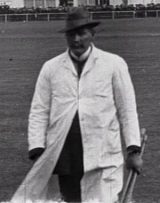
|
The original conflict had come four decades earlier when roundarm bowling challenged and successfully usurped the underarm style that had been a part of the game from the year dot. Bowlers had been gradually raising the height of the arm since the amendment, and despite MCC tightening the Laws in 1845, breaches continued. At The Oval in August 1862, Edgar Willsher deliberately bowled overarm and was no-balled six times in succession by umpire John Lillywhite. The irony was that Lillywhite was the son of the very man who almost four decades earlier had done so much to change the original Laws. Willsher and the other eight professionals in the England team walked off. Although they resumed the next day, the point had been made, and by 1864 MCC bowed to the inevitable and again changed the Laws.
As the 19th century drew to a close, the game was increasingly tarnished by simmering rows about the illegality of the actions of a number of leading bowlers. The class system of the era added to the difficulties. Umpires were largely professional and were loathe to call their fellow professionals whose livelihood depended on the game, and they would certainly not consider taking action against any amateur gentlemen. In the early 1890s Lancashire had dispensed with the services of two bowlers - Crossland and Nash - after other countries scrapped fixtures with them and in 1897-98 several leading players (most notably CB Fry, the ultimate Corinthian) were called. But it took an Australian umpire, Jim Phillips, backed by the powerful autocrat Lord Harris and egged on by Wisden, to take the bull by the horns. He no-balled Australia's Ernie Jones in a Test, and in 1901 ended the career of Arthur Mold, one of the most controversial figures, when he called him 16 times in one innings. By 1903, the crisis was over ... for a while.
|
|
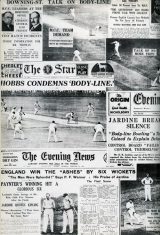
|
Almost three-quarters of a century on, it is hard to grasp what an effect Bodyline had on not only cricket but also politics. The on-field events of the series itself are well documented, and at one stage the whole tour was close to being cancelled as the two boards exchanged terse cables. It was even raised at government level. The MCC did eventually amend the Law concerning Bodyline, but Australia only agreed to tour England in 1934 after verbal assurances from the MCC that there would be no further Bodyline bowling. The legacy lingered for decades.
Since the turn of the century there had been isolated incidents - the most notable in 1941-42 when Mabarak Ali of Trinidad was called 30 times in one innings - but in the 1950s the problem of chucking returned with vengeance. Tony Lock was no-balled in a Test in 1953-54 but carried on amid a background of muttering, but the problem came to a head in the late 1950s when a string of fast bowlers with highly dubious actions emerged. Criticism of some Australians, particularly Ian MecKiff, in 1958-59 and the calling of Geoff Griffin at Lord's in 1960 ensured that action would have to be taken and a series of informal agreements between boards was backed by action on the field. In 1962-63 MecKiff was no-balled into retirement at Brisbane, and the issue again returned to the backburner. It was ironic that two of the main protagonists in getting throwing stamped out were Bradman in Australia and Gubby Allen in England - both central figures in Bodyline.
|
|
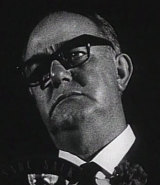
|
Basil D'Oliveira was a Cape coloured batsman of tremendous ability who had been brought to England in the 1960s and who made his Test debut for his adopted country in 1966. In 1968 he scored 158 in the final Test after being recalled, but was controversially left out of the side to tour South Africa that winter. Critics slammed the MCC for making a political decision so as not to clash with South Africa's apartheid policy - but three weeks later Tom Cartwright withdrew through injury and D'Oliveira was drafted in. That angered South Africa's government, and prime minister John Vorster, who said: "This is not the team of the MCC ... it is the team of the anti-apartheid movement." Voster added D'Oliveira would not be allowed to play, and MCC scrapped the tour. Australia toured the following winter, but the South African visit to England in 1970 was cancelled after massive protests, and the same fate befell South Africa's scheduled tour of Australia in 1971-72. It would be two decades before South Africa took the field for an official international match.
With South Africa isolated, attention turned to individuals who still earned money from their associations with the Republic. In 1977, the Commonwealth ratified the Gleneagles Agreement which was aimed at preventing teams having contact with South Africa, although there followed a UN blacklist against individual players. That led to the Jackman affair when, in 1980-81, Guyana refused entry to England's Robin Jackman, who had links with SA, and led to the cancellation of the Georgetown Test. New Zealand had their invitation to visit the Caribbean withdrawn because the country had allowed a rugby tour by South Africa in 1980-81. Feelings ran so high that a racial spilt in international cricket was for a time a possibility. And the situation took a turn for the worse in 1981-82 when a rebel England side became the first to break ranks and tour for money. Sri Lanka, West Indies, Australia and a second England team followed. Some of those participating faced life bans, while the English players got off far more leniently with three-year bans. One player, John Emburey, was actually banned twice after touring in 1981-82 and 1989-90, and returned from both to play for his country again.
|
|
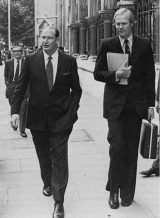
|
By the mid 1970s Australia's cricketers, who were still poorly rewarded and amateurs with full-time jobs outside the game, were on a collision course with the Australian Cricket Board (ACB). That was a fight it could handle. But when it snubbed media tycoon Kerry Packer's attempt to break the cosy broadcasting arrangement between the board and ABC, it was out of its depth. In May 1977, Packer announced the formation of a breakaway tournament - World Series Cricket - and revealed that he had signed up dozens of the world's leading players. After initial fury from officialdom, negotiations went on to try to find a solution but the international cricket community underestimated Packer's resolve or the depth of his pockets. Boards fumed. Some tried unsuccessfully to ban WSC players, but Packer took the English to the High Court and won. WSC itself started sluggishly but grew in popularity, and Packer introduced many innovations which are here to this day - coloured kit, white balls, day-night games, drop-in pitches - and in the end the establishment caved in and Packer won the TV rights which had been his goal all along. One other legacy was that for the first time players were paid a decent reward for their effort.
England's trips to India in the 1980s had been nothing if not eventful. The 1981-82 was in doubt for some time when the Indian government had threatened to refuse to allow Geoff Boycott and Geoff Cook entry to the country as they had played or coached in South Africa. In 1984-85 the tour was marred and for some time close to cancellation following the assassination of Indira Gandhi and the British consul. In 1988 the issue was once again links with South Africa, and Graham Gooch, the captain, and seven other members of the side who were on UN blacklists for their sporting links with South Africa were refused visas to enter. This time there was to be no compromise and the tour was scrapped. (Click here for BBC video report).
|
|
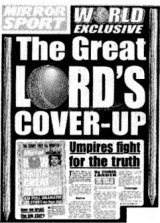
|
During Pakistan's tour of England in 1992, the tourists' bowlers triumphed, showing their mastery of the almost unknown art of reverse-swing. The British media made allegations against the bowlers, fuelled by reports that umpires had asked for the ball to be changed during an ODI at Lord's at the end of the summer. The ball itself was kept locked at Lord's and has conveniently since disappeared - incidentally, the same fate befell confidential documents held by the MCC relating to Bodyline! The row rumbled on until 1996 when Imran Khan sued Ian Botham and team-mate Allan Lamb who had been among the most vocal accusers. Imran won and was awarded £400,000 by a British court.
Probably the most serious and far-reaching scandal of them all first became public in the mid 1990s with stories of bookmakers and shady characters, although rumours had been doing the rounds about dodgy ODIs for some time. It really came to a head in 2000 when Hansie Cronje, South Africa's captain, admitted taking money for influencing certain facets of games, and with his confession others were sucked in, the most high-profile being India's Mohammed Azharuddin. Almost all - Cronje excepted - professed innocence, but hefty bans were meted out and the ICC acted decisively, establishing an anti-corruption unit to stamp the menace out.
|
|
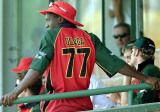
|
As the political situation inside Zimbabwe went into freefall, protests against the regime of Robert Mugabe grew, and in 2003 that spilt over into cricket when England refused to play a World Cup match in Harare and Andy Flower and Henry Olonga staged their courageous black-armband protest. Zimbabwe's tour of England that summer did take place, but politics and cricket inside the country clashed in 2004 when leading players went on strike. The exodus of key players which had been going on since 2000 grew, and a much-weakened Zimbabwe's performances on the field went into freefall. Twice their own board suspended them from Test cricket. Australia's tour in 2004 was scrapped midway through, and although England did tour in 2004-05, it was against a backdrop of threats of financial penalties from the ICC. In 2005-06, Zimbabwe were banned from entering New Zealand by that country's government. The Zimbabwe crisis affected white countries more than the others, but it remained a thorn in the side of the ICC, not least because it was widely accused of ineptitude for constantly refusing to address the issue.
Martin Williamson is managing editor of Cricinfo